We’ve got a secret
We really don’t want to tell you about Lucca, Italy. Because if we do, then you might go there and fall in love with it like we did. And then you’ll tell your friends and they’ll go, too. And while we know that you and your friends are all good people, sooner or later the word will get out and the “tourists” will show up, and then Lucca might be ruined.
OK. We’ll tell you. But you have to promise to keep it a secret.
Here’s how Rick Steves said it (emphasis is mine):
Lucca has no single monumental sight to attract tourists – it’s simply a uniquely human and undamaged, never-bombed city. Romanesque churches and shady piazzas filled with soccer-playing children seem to be around every corner. Perhaps it’s a blessing that Lucca has no Uffizi or Leaning Tower – that lack of big-league sights keeps away the most obnoxious slice of tourism: people who just want to tick an item off their bucket list. Instead, refreshingly untrampled Lucca seems to attract travelers who want to melt into the local lifestyle for a few days.
We spent 48 hours over three days melting into Lucca life. That was long enough to figure out that this is a place we want to return to.
Traveling at a slower pace
This trip is the first where we started to apply a new approach to traveling. We’re calling it “Slow Travel”, borrowing an idea from the “Slow Food” movement. We’ll have more to say about this in a longer post early next year, but here’s the gist of the idea.
Many of our trips have been organized around traveling “to see” things, like “We went to Rome to see the Colosseum” or “We went to Paris to see the Eiffel Tower”. But in Slow Travel, our objective is to go to a place, stay for awhile, and try to experience what it’s like to live there.
It means ditching the agenda, setting the guide book aside, and exploring on foot. It doesn’t mean skipping the famous sights. I mean, if you’re in Paris, why wouldn’t you go see the Eiffel Tower? (Though on our only trip to Paris, we only saw it from a distance.)
But seeing the Eiffel Tower, or the Coliseum, or whatever is only part of the experience. It’s also, and mainly, about visiting the local markets, walking in the neighborhoods, eating the local food, learning some of the history, talking to people who live there, and generally soaking up the ambience and essence of the place.
It means you stop being a “tourist” and start acting like a visitor. Or better yet, a guest. You’re a guest in someone else’s town or home.
This probably sounds funny if you recall our last post, where we did the exact opposite: We stopped in Pisa for about 14 hours, saw the Leaning Tower, took some pictures, and then left.
But this is an idea we’re still working on. And old habits, as they say, are hard to break.
Going to Lucca, we didn’t have an agenda. We weren’t going to see specific things or sights. No bucket list boxes to tick. We wanted, as Rick Steves put it, to “melt into the local lifestyle”, if only for a couple of days. We were going to spend time with friends in a place that was new to us, and we were curious about what we would see there. And we would be, literally, guests in their house.
Our hosts
We first met Ann and Laurie when we went on a tour of Western Europe in 2006. Since then we’ve traveled with them several times – to the Piedmont region of Italy in 2016 and to Sicily (with just Laurie) in 2019. Both of those trips were food and wine tours, letting us focus on our common interests.
They are both Americans of Italian ancestry who for several years have been thinking about moving to Italy. So this year they rented an apartment in Lucca for month as a test run. They invited us to stay with them for a couple of days.
So our agenda was simply to go see our old friends.
When we reached the apartment, we found that Ann and Laurie had laid out a huge spread of food from local shops – there was pizza, arancini (small balls of rissoto, stuffed with a savory filling, coated in breadcrumbs and fried), fried artichokes, fresh mozzarella, cheese, olives, and prosciutto. And, of course, some good local wine.
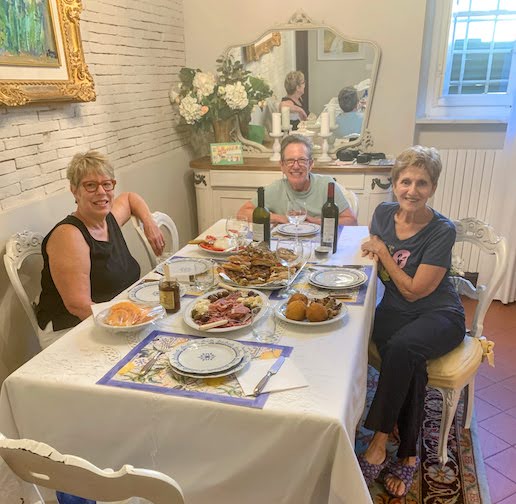
We spent a delightful evening just getting caught up on our lives and travels.
Living the slow life
Luckily, Lucca turned out to be a place with some interesting historical aspects and some good food. Here is some of what we experienced during 48 hours there.
The wall
Perhaps the thing that most distinguishes Lucca from other towns in the region is le Mura – the wall – that surrounds the oldest part of the city. Lucca’s wall is significant because, after almost 700 years, it is still standing, intact and well-maintained. Rather than being an archeological curiosity, it is an integral part of modern life for the people who live here.
People have been living in this area since at least the 3rd Century BC. Over the centuries, different fortifications were built to provide defense from invaders. The Romans built a wall during the 2nd Century BC. Segments of that wall are still visible today – embedded in the newer structures that were built around them.
Another set of walls was built in medieval times, around the 11th or 12th centuries. These enclosed more space, reflecting the growth of the town. At several places in Lucca, you can see large towers with arched gates that were part of the expanded walls.
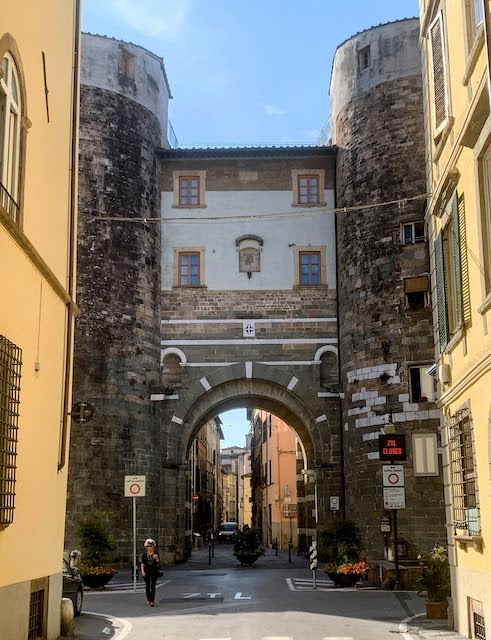
Even though the medieval walls were thicker – about 2 1/2 meters – they were deemed insufficient to protect against new military technology – cannons. So in 1504, an “Office of Fortifications” was created and charged with designing, building, and maintaining a new wall, which is the one we see today. (The Office of Fortifications was in operation until 1801.)
The new wall was built over a period of 150 years. It stands 12 meters tall, is nearly 30 meters thick at its base, about 20 meters wide at the top, and has a circumference of 4.2 km. There are six large gates and many posterns (smaller passageways) that allow entry into the old city.
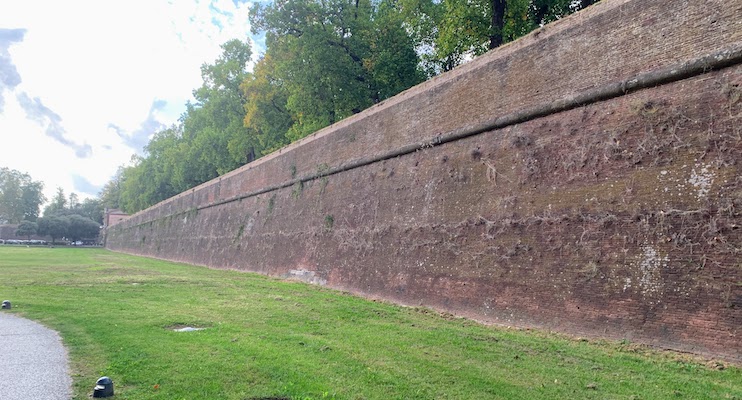
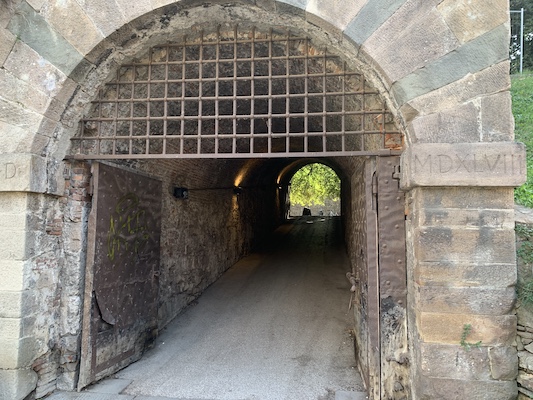
While this is an impressive fortification, it was never needed to defend the city from invaders. But it did protect the town from a natural disaster. In 1812, the nearby Serchio River flooded. The doors of the wall were bolted shut and reinforced with mattresses, helping to hold back the floodwaters.
In the 1820s, the top of the wall was converted into a pedestrian walkway, which is actively used today.
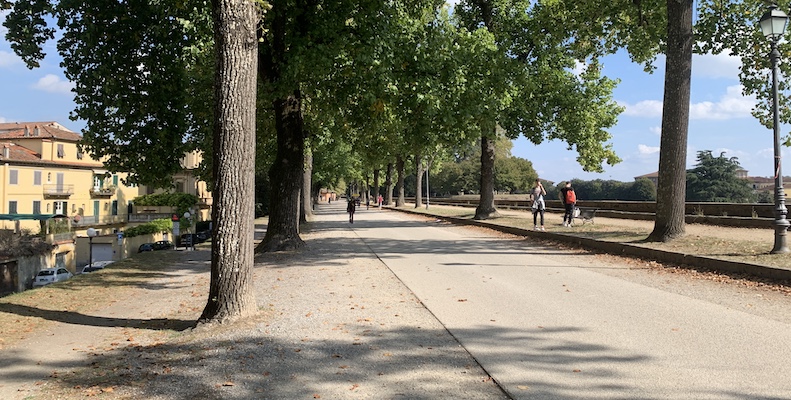
We found our way in through a baluardo, an opening in the wall that would have been used by soldiers defending the town. We walked up two flights of narrow stairs and came out on top. The pedestrian walkway was paved and level, with mature trees along its sides. It looked like a very pleasant place to take a walk, but we got off after only 100 meters, taking a ramp down into the inner city.
Inside the walls
Our first afternoon in Lucca set the tempo for the rest of the visit. We had a 1 1/2 km walk to the apartment and 4 hours to get there. There was plenty of time to slow down and enjoy the scenery. So we lingered over lunch at a café in a sunny piazza.
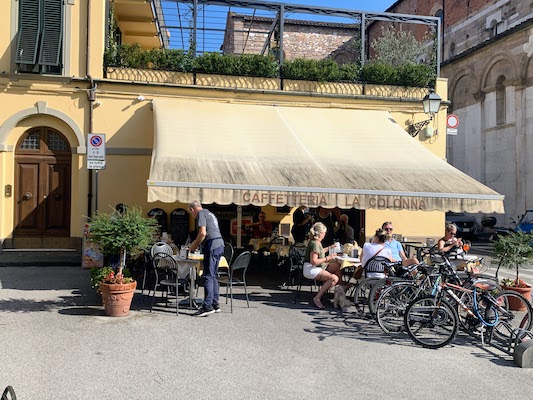
We took our time wandering through the cobblestone streets. For about an hour, we sat on a park bench and just watched the Lucchese going about their daily lives.
Fresh water on tap
At an intersection near the end of our walk, we saw several people step up to a large fountain to fill water bottles. So we topped ours off, too.
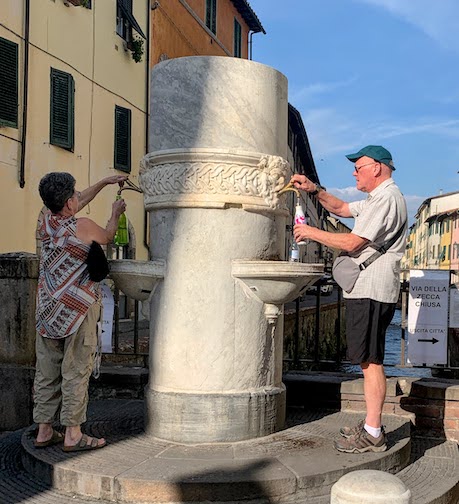
This is one of several fountains in Lucca that were designed by Lorenzo Nottolini, a 19th C architect. They are fed by an aqueduct, also designed and built by Nottolini, that has brought fresh water into the city since the early 1800s.
More wanderings
Over the next day and a half, we continued our slow wandering around the cobbled streets of the old walled city. We enjoyed meals at local restaurants. We stopped at outdoor cafés for Aperol spritzes. The soundtrack for our walks was provided by the many buskers playing their accordions.
And there were lots of delicious pastries to be tasted. The best were these pistachio cookies.
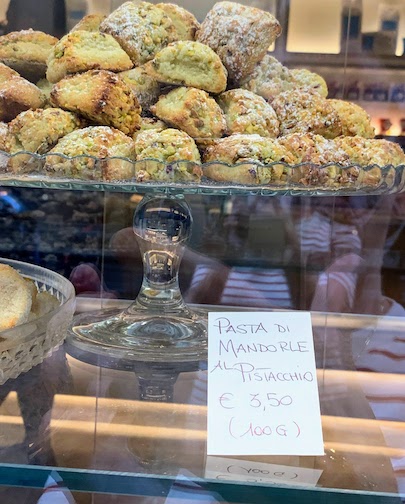
We strolled past shops selling locally-made leather goods and high fashion clothes, just around the corner from 12th century churches. One church, the Chiesa de San Michele in Foro (Church of Saint Michael in the Forum), is located on the site of the ancient Roman forum. It had a statue of the Archangel Michael at the top of it’s facade. The statue has hinged wings that at one time could be moved by a hidden assistant. This, we were told, was a real crowd pleaser in the 1300’s.
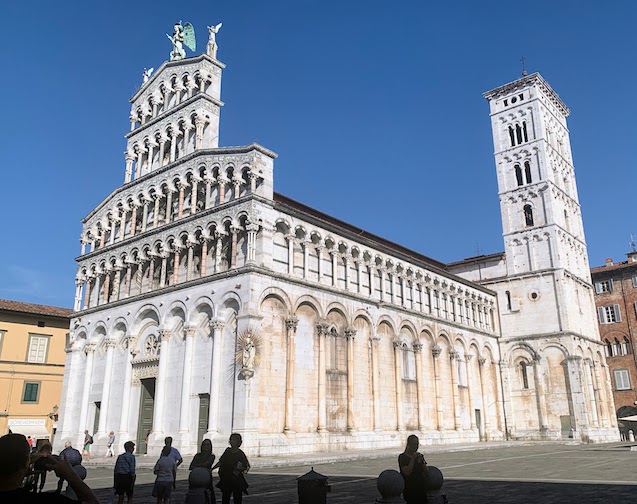
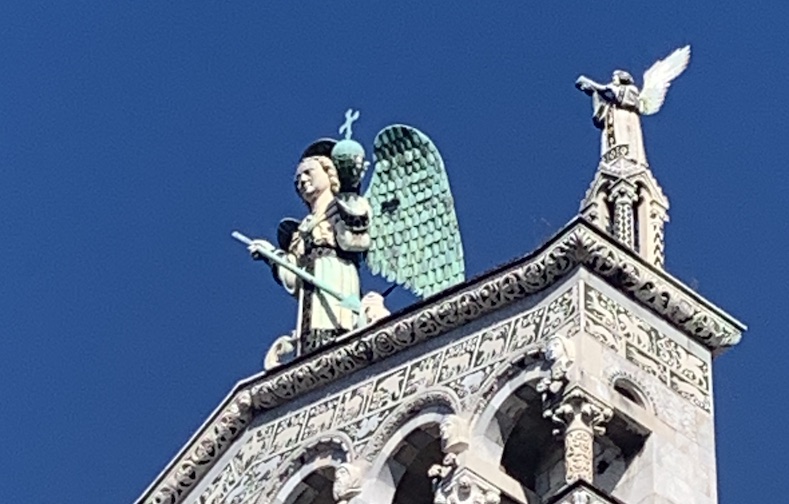
One building we intentionally sought out was the Torre Guinigi, the Guinigi Tower. Built in the 1300’s, it was typical of many that were found in Lucca at that time.
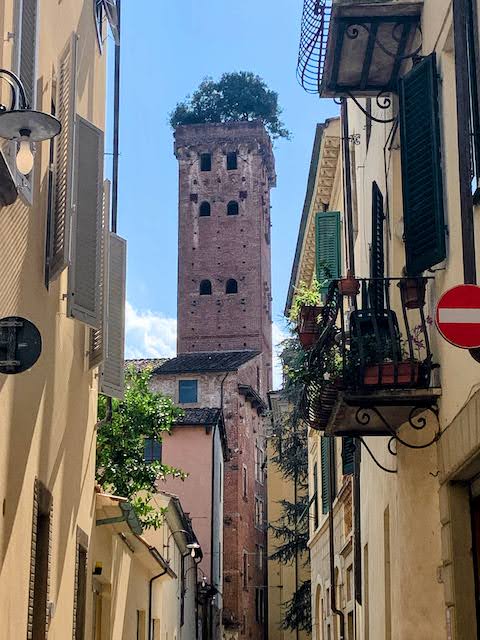
These tall structures were built as status symbols by wealthy Lucchese families. Each floor in the tower had a single room – living room, bedroom, kitchen. The Guinigi Tower also had trees planted on top, creating a shady garden where the family could enjoy their view across the city.
Slices of life
Our slow pace gave us the chance to see small moments of life happening within the walls.
There were kids waiting to ride an ornate carousel.
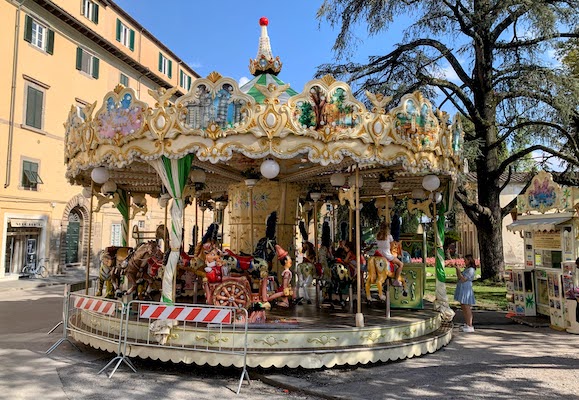
We heard businessmen negotiating deals over glasses of wine at an outdoor table.
On Saturday morning, we saw a bride posing for photos. She didn’t appear to be very happy and we wondered if the groom was late.
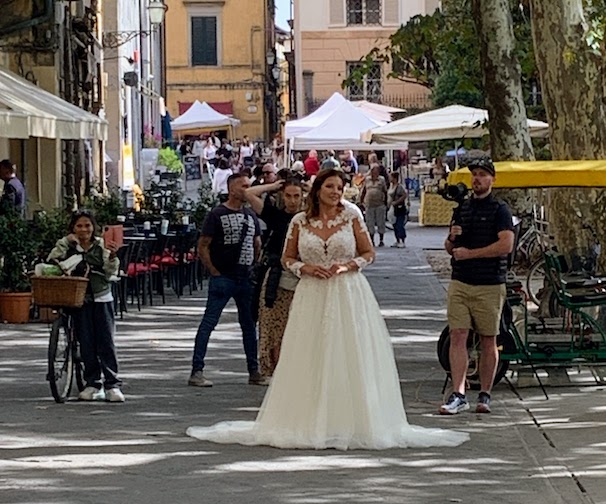
We even rented a “quadricycle” one afternoon and rode it around the top of the wall.
Even though it seemed like we were going down a gentle slope the whole way, these things are harder to pedal than they look. After one lap around the wall, we were happy to turn it back in.
(This perhaps adds another aspect to Slow Travel: If an opportunity presents itself that is legal, safe, affordable, and potentially fun, always say “Yes!”.)
And on our way back to the apartment late in the evening, we walked through a crowd of mostly young people gathered in a piazza. It was a warm, clear night and every table outside the cafés was full. Outdoor bars had been setup and people were standing in the street, drinks in hand, talking, smiling, laughing – an impromptu community party. Laurie and Ann told us this happened almost every weekend.
We’ll be back
Our visit to Lucca was brief, but long enough to give us a feel for the old part of the city. Next time we’ll explore the areas outside the wall.
We are looking forward to more slow travel trips in the years ahead. Whenever we can, we’ll pick a place and stay there for several weeks.
Until next time / Até a próxima vez
Mary and Mike
The Cook and The Writer
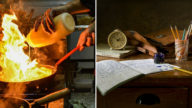
If you could go anywhere and spend a month, where would it be? We’re adding places to our “must visit” list. Leave your recommendations in the comments below or via the Contact Us form.
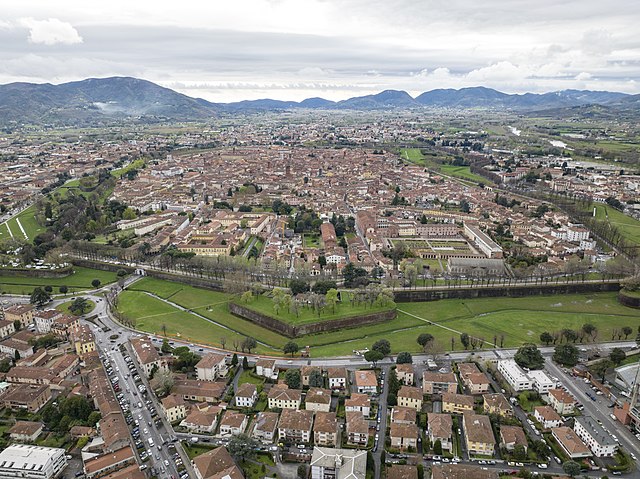

Wonderful description of Lucca!
Mike, you make it difficult in asking us to say where we would go, if we could, to spend a month. Maybe that’s why readers seldom answer such questions. But this time, my answer is: “some place different every time I read one of your posts, after watching a documentary on PBS, read a travelogue in a magazine, or when reminiscing about places I’ve already been, in your words, “a guest”. Tonight, my answer is Lucca, Italy…yesterday it would have been in Old Holland, wherever that is, looking up the ancestral home of “Weavers”, Tomorrow it might be the riverside walkway of Lucerne…next week it might be a mountain top somewhere west of Estes Park, Colorado where I fell in love 73 years ago.” So, there you go: pick one, any one will do!
I love you guys, Joy Cross
Wonderful to see the town again after visiting too many years ago. We have done slow travel for years, maybe because we are old and slow. Lol
Oooh, sounds very tempting to visit, I will say. Love your concept of “slow travel”. I think we’ve exercised that a few times, now that I think of it. It doesn’t leave you exhausted like the other kind of travel does. I delighted in your quad bike ride – even got some good exercise by osmosis – thanks!
Love the wall ride. Lucca sounds like a great hidden jewel. Happy Weekend M & M.
What a marvelous experience and great overall advice! And, you know what, I found myself even giving your delightful post a bit of a “slow read” so thank you on all levels! I promise not to tell anyone else about Luca . . . Shhhhhhhhh . . .